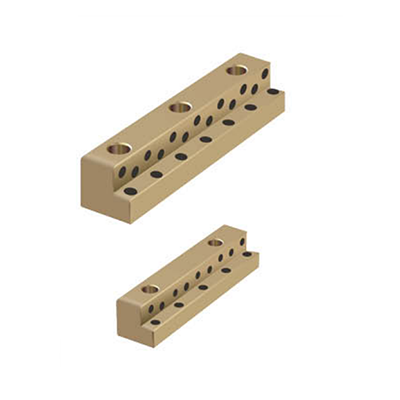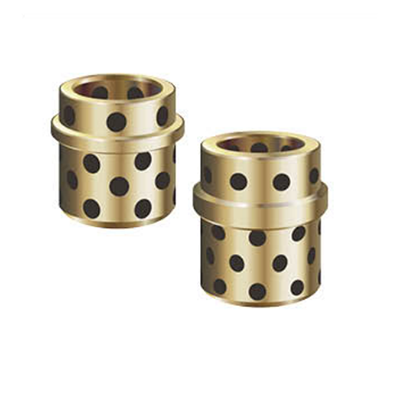1. The core role of Flange Bushing: Improving stability
Flange Bushing is not just a supporting component. It helps reduce unnecessary friction, vibration and load accumulation by providing precise support and positioning in the mechanical system, thereby effectively improving the stability of the system. When the equipment is running at high speed or heavy load, various external factors may cause displacement, vibration or wear of components. As a stabilizing component, Flange Bushing can eliminate these unstable factors and ensure the precise operation of the equipment system.
With the development of industrial technology, the precision and efficiency requirements of mechanical equipment are getting higher and higher. In this context, any unstable factors may cause the performance of the equipment to decline or even fail. Flange Bushing avoids unnecessary losses caused by friction and vibration between mechanical components through its stable supporting role, thus laying the foundation for the long-term stable operation of the equipment.
2. How does Flange Bushing eliminate friction and wear?
Friction and wear are one of the most common influencing factors in mechanical equipment. In a rotating mechanical system, excessive friction not only leads to energy waste, but also may accelerate the wear of components and reduce the service life of the equipment. Flange Bushing can help alleviate this problem by reducing friction. It ensures that the components in the equipment can maintain stable contact and reduce energy loss caused by friction through precise design and material selection.
During the operation of the equipment, the role of Flange Bushing is to reduce the friction coefficient between the components by providing precise support for rotating or moving parts. In this way, Flange Bushing significantly delays the wear process and avoids equipment failure and efficiency loss caused by improper friction. Especially in high-speed rotating equipment, Flange Bushing helps maintain stable contact between moving parts, thereby reducing the negative impact of friction on the system.
3. How does Flange Bushing prevent vibration and fluctuation?
Vibration and fluctuation are common stability problems in mechanical equipment, especially in equipment with high-speed rotation or complex movement. Even the slightest vibration or axis deviation may cause system instability, which will not only affect the accuracy of the equipment, but may also cause system failure or damage. The design and material selection of Flange Bushing are designed to solve this problem.
By providing precise support and positioning, Flange Bushing can effectively reduce vibration and fluctuation in equipment. Under the conditions of high-speed rotation or heavy-load operation, Flange Bushing ensures the stable docking of various parts of the equipment through its structural characteristics and high adaptability of materials to avoid mutual interference caused by vibration. It can eliminate the unstable factors caused by component misalignment or friction, thereby ensuring that the equipment can still maintain a stable working state under extreme conditions.
This anti-vibration function of Flange Bushing is particularly important for some equipment that requires high precision and high stability. For example, in some precision instruments or high-speed rotating mechanical systems, any slight vibration or deviation may lead to a significant decline in performance. Flange Bushing helps the system remain stable by optimizing the support structure, thereby effectively reducing the occurrence of vibration.
4. How does Flange Bushing adapt to complex working environments?
The design and material selection of Flange Bushing are usually specially optimized according to the working environment of the equipment. Mechanical systems are usually faced with complex working conditions, including high temperature, high speed, high load and corrosive environment. In these environments, Flange Bushing can still play an excellent stability and support role to ensure that the equipment can continue to operate under extreme conditions.
For example, in a high-temperature environment, the material of the flange bushing needs to be resistant to high temperatures to prevent thermal expansion or material deformation caused by temperature changes. At the same time, its structural design must also take into account load changes and vibration effects to ensure that the equipment remains stable under these conditions. By using special alloy materials and precise design, flange bushing can maintain efficient and stable performance under various complex working conditions.
In addition, flange bushing also has strong corrosion resistance, which enables it to provide stable support in some harsh environments (such as humid, chemically corrosive environments, etc.). Whether in extreme temperatures, humidity, or under high loads or high-speed operation, flange bushing can effectively prevent wear or failure caused by environmental factors, thereby ensuring the long-term stability of the equipment system.
5. Application of flange bushing in high-precision equipment
In many high-precision mechanical equipment, the role of flange bushing is particularly important. In these devices, any slight instability or deviation may lead to a significant decrease in performance, affect production efficiency, and even cause equipment failure. Flange Bushing helps avoid these potential problems by providing precise axis alignment and support, ensuring that the equipment can maintain excellent accuracy and stability under high-speed and heavy-load conditions.
For example, in some precision instruments or high-precision processing equipment, Flange Bushing can ensure the precise alignment of the axis of the rotating shaft or moving parts to prevent deviation and instability caused by misalignment. This precision guarantee allows the equipment to continue to operate efficiently and avoid the adverse effects caused by vibration or misalignment.

 English
English Español
Español



